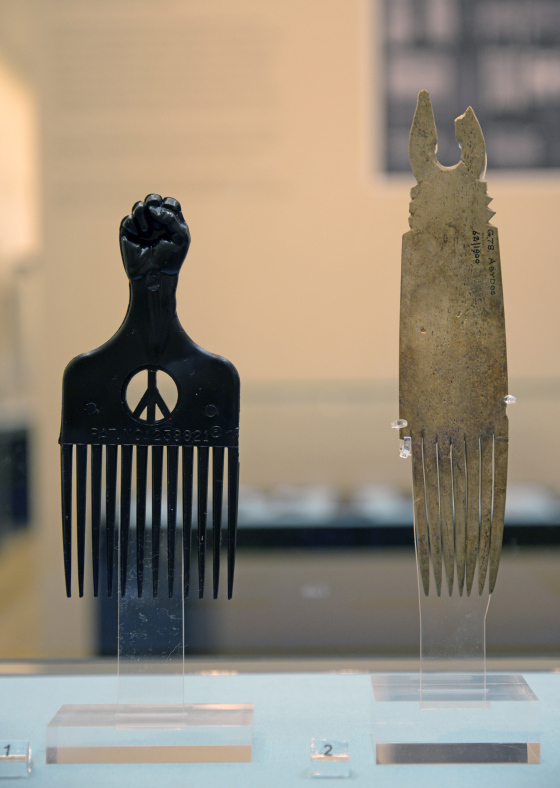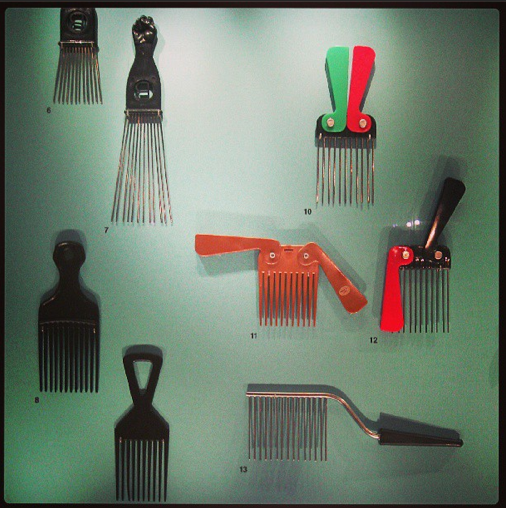
Today we look at personal stories of hair politics, an anthropological exhibit dedicated to the afro pick (raise fist everybody), and the role of our hair in pop culture.
The 6,000-year history of the Afro Comb, its extraordinary impact on cultures worldwide, and community stories relating to hair today are being explored in a new exhibition at the Fitzwilliam Museum and the Museum of Archaeology & Anthropology in Cambridge.
The display at the Fitzwilliam Museum includes hundreds of remarkable combs – from pre-dynastic Egypt to modern-day black fist combs referencing the Black Power Movement – as well as associated images and sculpture showing the wide variety of hair styles found in Africa and around the world. A digital interaction gallery features projections of personal stories about combs and African type hair and visitors are encouraged to share their own stories and photographs, which will become part of a new archive of material for future generations.
Hair and grooming have always played an important role in the culture of Africa and the African Diaspora. The traditional African comb or pick has played a crucial role in the creation, maintenance, and decoration of hair-styles for both men and women.


In many African societies, ancient and modern, the hair comb symbolizes status, group affiliation, and religious beliefs, and is encoded with ritual properties. The handles of combs are decorated with objects of status, such as the headrest, human figures, and motifs that reference nature and the traditional spiritual world.


In the twentieth century ‘afro’ combs have taken on a wider political and cultural message, perhaps most notably in the form of the ‘black fist’ comb that references the Black power salute.
Afro Comb Facts displayed in the exhibit include:
- The earliest African hair comb that we know of is 5500 years old.
- African people have been wearing their hair combs in their hair for thousands of years.
- The handles of many hair combs contain political, religious or cultural references.
- Between 1970 and 1980 thirteen afro combs were patented in the USA.
Journalists of Color – Hair Scares.
Melba Tolliver got the assignment of the year in 1971

President Nixon’s daughter, Trisha, was marrying Eddie Cox, and Tolliver was to go to Washington D.C. to cover the presidential event. Reporting for WABC in New York, at the time it was unusual for a local station to send a reporter out of town on a national story. However, television news was learning that ratings increased with coverage of such spectaculars. WABC, too, had reached number one ratings in the market and had done so by creating news personalities, reporters and anchors that audiences would grow to love and trust. Perhaps it was the beginning of entertaining news. The station took great pains to make sure the staff was ethnically diverse. Tolliver, an African American and Geraldo Rivera, Puerto Rican, were some of the “identifiable ethnics” on staff.
Tolliver had been thinking for some time of changing her hairstyle. She was tired of processing her hair, and using wigs. So she decided to go natural, and made the switch the week of her assignment to Washington D.C. It was a modest afro, carrying little of the bold statement of say an Angela Davis afro.
“It looked wonderful,” recalls Tolliver. “People were on game shows with naturals. Cecily Tyson was on with it. Everybody was wearing them.” So she expected little opposition.
The day she switched to a natural, she was assigned to cover a dinner in Midtown. Her colleagues were shocked. Some on the crew said to her in noncommittal tones, “Oh, you changed your hair.” By the time she got back to the office, everyone on staff knew what she had done. One producer saw her and asked, “What did you do to your hair.”
Tolliver replied, “This is what my hair is like. Now I’m not going to straighten it any more.”
The news director had heard too, and he was on the phone as soon as she finished the evening news. “I hate your hair,” he said. “You’ve got to change it. And you know what, you no longer look feminine.”
Management threatened to keep her off the air if she didn’t change her hair back. She went to Washington D.C. for the wedding, covered it the only way she knew how using live shots of herself, and let New York decide what to do with the footage.
When she returned, management was insistent that she had to straighten her hair or she’d have to wear a hat or scarf if she wanted to get back on air. Now the New York Post had gotten wind that something was happening at the station, and people were beginning to wonder why they hadn’t seen Tolliver on air. When the Post began calling people at the station, including the news director, the station backed down and put her on the air. But by now word had gotten out what had happened. It was bad publicity for the station. People wrote letters supporting Tolliver’s right to wear her hair as she pleased, even if no one liked it.
It was a defining moment in television history as African Americans grappled with how to define themselves. The struggle spilled over into other realms of journalism, but Tolliver insists this was not the defining moment of her career.
Renee Ferguson scares the white people!

I’m a broadcast journalist. Employed in a visual medium, I have had more discussions about my hair with news managers over a 30-year career than I ever wanted to think about. So when the Imus imbroglio hit, I was reminded of my first broadcasting job at Channel 13 in Indianapolis.
It was the 70′s. I was in my 20′s, and the black revolution’s cultural mantra, “black is beautiful,” had helped give me the confidence and self-esteem to believe that I could take the leap from print journalism to broadcasting. There were almost no black women working in television news at the time, virtually no role models for me to emulate, so I made my own way. I had won awards for newspaper writing and submitted my clippings and got the job. I was told by the news director, a white man, that I was hired based on my skills as a writer and reporter. He was a blunt but nurturing teacher who shared his knowledge and skill to teach me the intricacies and subtleties of broadcast journalism. His role in my career is immeasurable. It was during one of our after-the-news critique sessions that our unforgettable conversation occurred.
“Renee, you’re going to have to get rid of that Afro,” he said.
“What do you mean get rid of my ‘fro?,” I shot back.
“We’re getting a lot of calls from our viewers. They say you look militant, like Angela Davis. You’re scaring them!”
I argued that they should be looking at my reports, not looking at my hair. He replied that they couldn’t see my reports because my hair was a distraction. There was no documentation of the race of the callers, but I assumed they were white.
“You’re saying I scare white people,” I said, as our words became more heated.
My news director artfully stepped around what was the elephant in this room. “Black militants scare all kinds of people, black and white,” he said. “We’re not in the business of chasing off viewers.” The threat was implicit—lose your Afro or lose your job.
Ironically, I had been thinking of straightening my hair, because I had gotten bored with the ‘fro. I wanted to change my hair as a matter of fashion and was contemplating undergoing the lye-driven, scalp-burning process just to change my look. But after this confrontation, I knew I couldn’t. I realized that my natural hair was making a powerful statement about my identity, about my blackness. It symbolized a demand for acceptance of me from the inside, beyond external issues of skin color and hair texture.
I kept the Afro for a year, wasn’t fired, and when I did straighten my hair, there were people who called the TV station to complain about that, too.
Hair-raising Athletes



Its no secret that the sports media complex is dominated by middle aged white men. Men that undeniably are out of touch with the athletes they cover via print, radio or television. On more than one occasion, athletes have had their appearance dominate how they are reported, far more than the skills displayed on the court or field. Negative connotations have been placed on black athletes and their hair for decades, and it still happens today.
Julius “Dr. J” Erving was not only the “face” of the ABA, he was the “hair” of the ABA.
When he dunked over a helpless opponent, it seemed that his afro was in on the action with some serious intimidation. And, who could forget Erving’s afro flowing backwards during his famous “free-throw line” dunk at the 1976 ABA All-Star game?
Michael Jordan, when he began to go bald, didn’t try to hang on to the few strands. Michael began to shave his head when his hair line started disappearing. Instead of it sticking out like a sore thumb, more people joined in. Increasingly, you would see more and more people shaving their heads instead of hanging on to what little hair they had left.
Next came the cornrows by way of “The Answer”.
Allen Iverson’s cornrows and tattoos were revolutionary in the fact that for the fist time, a major athletic apparel company (Reebok) would purposely use the “black rebel” moniker to market its products.
In their haste to demonize, the sports media ironically anointed Richard Sherman of the Seattle Seahawks the face of the NFL…dreadlocks and all.

Who can forget when the Williams Sisters came on the scene, hair beads became an actual discussion on the tennis circuit while they kicked all the country club butt in the process.


To find out more on the Afro Comb exhibity visit-http://www.originsoftheafrocomb.co.uk/
[Source: POU]












